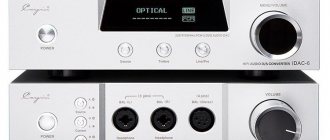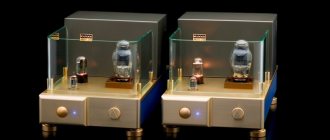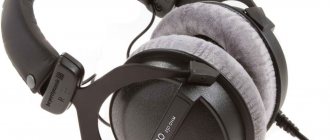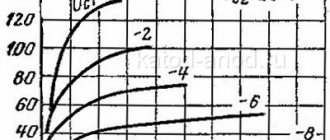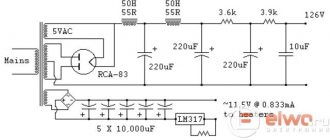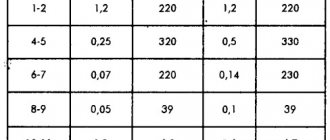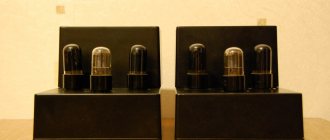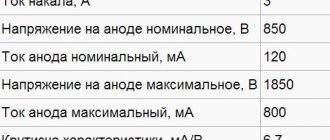The values and brands of parts that were used for the SE 300B amplifier are shown in the figure. Resistors R7 and R8 will need to be adjusted slightly during tuning to achieve the voltages shown in the diagram. The circuit is for one channel, with the exception of the power transformer (T2), which is common to both channels of the amplifier. The test point voltages will vary between tubes, so don't expect them to match the voltages shown exactly. Remember that the maximum anode voltage for a 300B lamp is 450V.
To adjust B+, a resistor is inserted into the power circuit (R8). To improve quality, an anode choke (L2) was added to each channel. Resistor R7 was adjusted from the original value of 27k to 15k to achieve the desired voltage. While the power transformer (T2) is common to both channels, each audio channel has its own rectifier, inductor, and filter capacitors. The use of separate rectifier tubes (5U4-GB) for each channel reduces voltage losses. More detailed information on all lamps will follow. The 300B anodes receive 430V. By decreasing R8 you can increase B+, but note that the maximum anode voltage for a 300B triode is 450V.
For the sound transformer (T1), Lundahl LL1623 was used. Lundahl is a leading manufacturer of audio transformers. Use any available power transformer and chokes. Power transformer 400-0-400 V 250 mA, 5 V 5 A, 6.3 V 6 A. The power transformer (T2) is common to both channels of the audio amplifier.
To improve filtering, it was decided to use 5V voltage regulators for the 300B filaments. In the initial version, we tried two voltage regulators like the standard 7805 in parallel for each channel, but the current consumed from 300B was too large for the 7805. Next we tried the LT1085 - this is a much more powerful chip and it coped with the task perfectly. For reference, we show the pinout for 6SN7, 300B and 5U4GB.
↑ Diagram of a transformerless headphone amplifier
The well-known SRPP amplifier circuit for high-impedance 6N6P headphones was taken as a basis. See, for example, this article “Project VINTAGE” and its materials.
I started with the fact that I needed to decide on nutrition. I decided to assemble a switching power supply based on the article “6E5P, 6N8S + 6N13S. Two tube amplifiers for high-impedance headphones with a switching power supply" on IR2153. I made a signet, wound a transformer, put everything together and started the power supply. Everything worked, the voltage had to be adjusted a little by rewinding the transformer, I tinkered with the current transformer, but still didn’t understand how it was supposed to protect against overload. I turned it on with a load through a lamp, everything is fine, it starts stably. I removed the lamp, the normal start heats up two 6N6P, the anode provides 300 Volts.
But then my success came to an end. When I connected the anode to the amplifier, assembled simply on the table, and began to listen, after 1.5 minutes the mid-frequency background began to increase and BANG!!! SILENCE... The mains fuse was torn to shreds, the MOSFETs were killed, the IR ran out, and one ultrafast in the anode rectifier broke.
The root cause was precisely the breakdown of ultrafast in the anode rectifier due to excessive heating. I changed everything and started experimenting again. The ending was similar.
ULF circuit on class A HI-FI lamps (2A3 lamps)
Is there something wrong? Please disable Adblock.
The QRZ.RU portal exists only through advertising, so we would be grateful to you if you add the site to the list of exceptions. We try to place only relevant advertising that will be of interest not only to advertisers, but also to our readers. By disabling Adblock, you will help not only us, but also yourself. Thank you.
How to add our site to AdBlock exceptions
The above circuit operates with input signals with a level less than 0.5 V; if the signal level is higher, distortion appears. In the input stage, the signal voltage is amplified by approximately 7 times, and in the second amplification stage, the voltage increases another 10 times. Both stages use 56 type triodes (VI and V2). The output stage uses a V3 type 2AZ radio tube. To supply a 45V bias voltage to the V3 lamp grid, two 22.5V batteries are used in series (B1). In this circuit (as in other class A amplifiers), a direct current flows through the primary winding of the output transformer T1. To eliminate this, a modification was made to the circuit shown in Fig. 8.16. This change allows you to remove the DC component in the primary winding current, although at the cost of some power loss. The amplifier assembled using a modified circuit has a flat amplitude-frequency response (unevenness of no more than 1 dB) in the band from 20 Hz to 20,000 Hz.
(The modified circuit requires that a high-voltage transformer be used in the power circuit.) It should be noted that transformer T1 has only half of the primary winding connected, for which the middle terminal is used. This is done because the transformer used must have a primary impedance of approximately 8000 ohms. The recommended load resistance for a 2AZ (V3) lamp to obtain maximum output power is 2500 ohms, but increasing the load resistance reduces distortion at the cost of only a small reduction in output power.
Analogues of foreign parts can be found in the section
↑ Nutrition. Winding TAN on a torus
Then it was decided to follow the old beaten path and reel in the TAN.
I came across a torus trans with mains and two 12-volt windings. It was decided to adapt it. I edited the diagram a little and this is what I got. Fragment excluded. The full version is available to patrons and full members of the community.
The second stage of extraction of supply voltages began; a shuttle was made from an aluminum rod, which was hidden after trimming the cornice of the vertical blinds. It is used there in the mechanism for turning the lamellas. The rod has a tetrahedron cross-section and is perfect for the shuttle. I attached two pieces of aluminum wire with a diameter of 3 mm to both ends with electrical tape. The result is a spear like this. I chose the length of the shuttle 300 mm.
As I already mentioned, a toroidal transformer with an outer diameter of 80 mm and an inner diameter of 40 mm was taken as the basis. It had a 220 V winding and two 12 V windings. I did not disassemble it, but to determine how many turns I needed to wind, I took and wound 30 turns, connected the trans to the network and measured the voltage on the new winding, then loaded this winding lamp 12 V / 21 W and made an amendment. Thus, I calculated the number of turns per 1 Volt.
I also measured the length of the wire used to wind 30 turns, thereby determining how many meters I needed to wind a new winding and obtain the calculated output voltage. This amount of wire had to be wound onto the shuttle first. Since my shuttle was 300 mm, one turn on the shuttle was 0.6 m. Thus, I wound the calculated amount of wire onto the shuttle, adjusted (5 turns on the shuttle) for the gradual thickening of the torus as it was wound.
I wound the filament winding with a middle terminal, that is, two windings of 3.15 V each. To make winding convenient with both hands, I came up with a clamp made from a vice and a clothespin-clip. I took a specially made plastic one, but at first I was thinking of buying an alligator clip for welding or for wires for lighting a car (the jaws will need to be insulated with plastic covers so as not to damage the insulation). The only condition is that the spring force be enough to hold the massive torus.
To get 235 VAC I needed to wind 1840 turns. At first I thought it would be hard and long, but after 3 hours of winding in two days I got a good TAN with many voltages: 235 V; 245 V; 255 V; 265 V; 3.15V + 3.15V; 2×12 V.
Several taps of the secondary winding were made to select voltages. After winding, the TAN was connected to the finished prototype, which was assembled during testing of the pulsed power supply. The power supply has so far been organized without an electronic throttle. There is no background, which is very pleasing.
The 300B tube and 300B amplifiers are a life-giving tube.
We are discussing amplifiers on this old but living tube.
The 300B lamp originated in the 1930s from Western Electrics. 2A3 and 6L6 are also from that time!
Stereophile.com – 27 Nov 99
In Search of the Perfect 300B Tube
In the last two years, the available choices in 300B output tubes for one's low-wattage single-ended power amplifier have become an embarrassment of riches. If we include the souped-up versions—which, in fact, deviate from the original 1930s Western…
Tube Maze
300B - Tube Maze
Reviews of 300B vacuum tubes and equivalents
https://www.antiqueradio.com/300B_01-98.html
Latest updates - January 2018
300s are the most common and least controversial lamps. Why they are good and what myths about them are a separate topic.
Here is a rating based on experience, analytics and subsequent verification in various systems: mine and people whose experience I trust. These people are my personal “contacts” from different countries in Europe, America and Asia; These include experienced owners of entire collections of tubes, and developers or manufacturers of amplifiers using 300B tubes, and distributors of these tubes.
The rating is made in order to navigate prices, sound level, reliability, etc. It can be updated as experience is gained. And one more thing: you need to be extremely careful when buying lamps, especially at auctions, especially not new ones. This could be a separate article. But the bottom line is this: based on experience, I only buy lamps from the most reliable sources, usually from distributors.
- An asterisk and (3) a number in brackets means that the lamps were tested personally and/or in systems well known and understood by me; the number means in how many systems. If the number becomes large, then I stop counting them or doing a very careful analysis, unless some contradictions emerge.
All prices are American unless otherwise noted.
From best down to good. Within the levels the logic is the same: down from best to good:
LEVEL 1.
Ceiling level for sound.
The difference between any of these lamps and, for example, TJ Full Music 300 B/n Premium Mesh or Sophia Electric Mesh is huge. As if I changed the amplifier to 2 classes higher. My conclusion is that good lamps are absolutely essential.
- * (4) - Western Electric old ($3500-7000, if you find it) - produced from 1938 to 1988; better than the new WE, which does not fall into the category of the best. It is extremely difficult to find old WEs, and also to avoid getting into trouble and to be in the declared new condition and to be reliable... Reference: they were produced from 1938 to 1988.
— * (11) — Takatsuki TA-300B ($2500) , Japan since 2010. The reviews say that the best and closest to the standard are the old Western Electric. One American review says that Sophia Royal Princess is slightly inferior in bass and drive, i.e. this lamp is for those who listen to jazz and vocals; for dynamic, fast music Sophia / TJ may be preferable, but as a replacement for the old Western Electric - quite good! Some prefer the old WE, others prefer the Takatsuki. But what I hear is amazing, and the bass and drive are all right, and the immersion in the music is complete, it’s simply amazing, they are better in everything than the “new” WE, TJ Special Edition and Sophia Royal Princess, both in bass and drive too. Slowly, as more and more people hear this lamp, the conviction has developed that this is still the best 300 of all time. An American 300B amplifier manufacturer I respect considers the Takatsuki to be in a different class to the Sophia RP and up there with the best of the old Western Electrics. The Asian distributor of 300B tubes called Takatsuki “magical” and also considers it the best. We also listened to it in Moscow in several systems in comparison with different new-made Western Electric and TJ Special Edition. We also listened in Norway in a super system with a whole set of the best 300s, with the old WE and with the new Elrogs in particular (warning about Elrog - see below). At the end of 2022, when there were already too many direct comparisons of these lamps from all over the world by different people with whom I have direct contact - and I, using different lamps, compared them more than once with other famous lamps - it is absolutely clear to me that these are the best modern lamps. In terms of sound level and reliability. And yet, the old WE have a unique sound, tone, Takatsuki is more neutral in comparison. Ideally, have both of these lamps, and then others are not needed, because They will simply lose in terms of sound level / musical information, but the old WE are no longer there and will not be.
Reference: made in Japan, since 2010.
https://www.takatsuki-denki.co.jp/index.html
https://parttimeaudiophile.com/2012/10/04/takatsuki-ta-300b-and-border-patrol-s10-exd/
https://www.highfidelity.pl/@main-206&lang=en
*- (1)- TJ Full Music Q is the newest 2022 tube from TJ Full Music. A distributor who has been dealing with TJ tubes since the early 2000s (and the only reliable source in my opinion for purchasing these tubes, because 1. they test all the tubes themselves, 2. reputation), says that Q is better than CNE. Because The lamps are new, the issue of reliability remains open. In a couple of years, or better yet in 5, we will understand.
- *** (2) - TJ Full Music CNE ($990-$1150)** - appeared in 2014, no reviews yet, but first impressions from a trusted source comparing them to TJ Full Music SE, Takatsuki TA-300B, PSVANE T2 and, from memory, with new Western Electric ones. Conclusions: TJ CNE is slightly better than TJ SE, it is made very well, but the main thing is that it is expected to be more reliable compared to Sophia Royal Princess and TJ SE. As of the end of 2016, the lamp has proven itself, more reliable and better. Comment for all Chinese lamps: you need to be VERY careful in purchasing them, no auctions, only trusted distributors. About TJ, see below, there is only one trusted distributor, the prices are the same, and there are incomparably more guarantees.
- * (7) - Sophia Electric Royal Princess ($1200 or 1300 euros in Europe) - absolutely rave reviews.
This review says that this is the best lamp of all time and that they are much better than WE
https://www.positive-feedback.com/Issue57/300B.htm
But after reading carefully, you understand that the reviewer does not talk about the difference between old and new WE, nor which WE he compared with. It is only clear that I compared it indirectly, and the conclusions are as follows: the lamp is good, the review - hmm, you can’t screw it up like that.
Conclusions from many reviews and comparisons on the Internet, mine and colleagues:
They differ in presentation from WE (“new”) - they are more driving. Some reviews suggest that for slow music, jazz, vocals, the old WE and Takatsuki are better, and for versatility and drive, the Sophia is better. I categorically disagree with this: in comparison with WE (the old ones) and Takatsuki, Sophia RP falls short in development and musicality. The dynamics of Sophia RP are at the level of Takatsuki, but the overall level is certainly lower. I haven’t heard the old WE and how their drive is, so due to the paucity of information, I’ll assume that it’s worse than the Sophia RP. It turns out that Takatsuki is more universal, and the old WE and Sophia RP are more genre-specific. The reliability of the lamps is lower than that of the best lamps, I heard this from 5 people! competent sources and continue to hear for several years now, although Sophia makes a replacement, but it takes time, stress and money. Comment for all Chinese lamps: you need to be VERY careful in purchasing them, no auctions, only trusted distributors, especially when it is known that Sophia Royal Princess lamps are not the highest reliability, buy only from them or their dealers, the risk of being left with a year later is too great one working lamp out of two.
— * (3) — TJ Full Music 300B SPECIAL EDITION ($740 - $900) - analogue of the Sophia Royal Princess lamp. More precisely: the same lamp simply under the name Sophia Royal Princess. Sophia makes 1.5 (2 in Europe) times more, selling under its own name and guaranteeing a replacement, if anything happens, in America and Europe. Sophia denies this, says: “No! This is our special order to our specifications and is much more reliable!” Don't believe it. I don’t believe and have not yet found anyone who believes. I found a user for both Sophia Royal Princess and TJ SE, a rare person, usually people buy one of the two, few in the world have heard of, much less compared, both lamps. So, he says that he doesn’t hear the difference between them.
The reliability of the lamps is not the highest, lower than that of the TJ Full Music Premium Mesh, so I would look at the TJ CNe model, which is both better and more reliable. Comment for all Chinese lamps: you need to be VERY careful in purchasing them, no auctions, only trusted distributors.
Sophia previously sold TJ lamps as an exclusive dealer in the US.
https://www.enjoythemusic.com/magazine/equipment/1201/300b/
But! It is much easier now to sell under your own brand and develop it than to fight with the Chinese who sell the same TJ or something similar to TJ from China to anyone cheaper and without guarantees of quality, it may be completely illiquid, depending on your luck.
That’s what they did: they agreed that TJ would produce for them, set prices 2 times higher in order to increase the level of service, guarantee quality, promote and build their American brand (and not someone else’s Chinese one) and fight counterfeit goods. The strategy is good and correct: it’s good for the consumer and for the company, well done!
And TJ, at the same time, does what all the Chinese do, and no Sophia can prohibit TJ from doing this: TJ sells the best they have invented, both to Sophia and under their Special Edition sign.
Although... who knows. Here's how a Canadian dealer explains the difference between the quality of lamps, selling the same PSVANE lamps, but of different quality levels... the English there is clumsy, obviously not native:
https://psvanetube.com/wordpress/psvane-tubes-gf-test-method/
They say that the factory checks and makes a selection of lamps according to only 1 parameter, but they use 5. As a result, there are 3 levels of the same pair of lamps: GF is the name of the dealer - in the selected pair the differences between the lamps are 5-10% in 5 parameters. Then - lower and lower to 20% and according to the 1st parameter.
Maybe Sofia does the same. But I don't believe there is much difference between Royal Princess and TJ SE.
Logically and knowing the business, it can’t be. And my choice from this category is either Takatsuki or TJ 300B SE. In Hong Kong you can buy a TJ 300B SE from a reliable supplier for $740 + shipping (80-180 for EMS)
For orientation, here are reliable TJ Full Music dealers (beware of purchases from the Chinese on ebay!, it won’t even be a pig in a poke, but TJ Full Music is guaranteed not to be what it should be):
- Parts Connection (former guys from the legendary company Sonic Frontiers)
https://www.partsconnexion.com/tube_new_full_music.html
- Diy Hifi Supply is a Hong Kong audiophile boutique run by Canadian Brian Cherry, an audiophile with 40 years of experience who has lived in Hong Kong for decades.
https://www.diyhifisupply.com/opcart/index.php?route=product/category&path=159_160
LEVEL 2.
From best down to good. Just a few years ago it was a ceiling, and before the advent of Shuguang Black Treasure and the upper PSVANE, the best and most reliable were only 3-4 lamps! old (NOS = new old stock) Western Electric, KR, TJ 300B/n Mesh Premium and new Western Electric, which even lost to TJ in some places, see here:
https://www.enjoythemusic.com/magazine/equipment/1201/300b/
— * (7) — Western Electric “new” ($2500-3000) - they are also no longer produced, but at least the reliability of the lamps is high. It's difficult to find. There were rumors that after the next move of the plant, or rather the equipment, their production would resume in 2014. This did not happen and now their prices at auctions are rising. The same ones that cost $850 10 years ago now cost 2500-3000 or more. There are also rumors that the sound differs depending on the part. Reliability is normal, there are cases, but it happens to everyone, the main thing is that it doesn’t go off scale.
Reference: these lamps were produced by Westrex; Charles Whetener bought the equipment and license to use the Western Electric name, and also hired old WE factory workers; the lamps were produced from 1997 to 2008 and were internally different from the original WE. Very beautiful boxes, including sometimes wooden gift boxes, with beautiful documents inside. I had these at different times on the test,
https://www.westernelectric.com/products/300b.html
ATTENTION: Another lamps under the Western Electric brand are planned to be released at the end of 2022. 1. Technologies will be different, because some of those old materials are not available now and 2. It will be a good lamp, whether it is reliable, time will tell, for a long time, it will take at least 2-3 years, or better yet even longer, 5 years. This is a fact, it is impossible to do otherwise.
There is NO NEED to chase WE, the old ones because of prices, or the “new ones” because of sound-price.
- * (3) - Living Voice 300B (EUR 1200) - a manufacturer of speakers for $600 thousand, and part-time distributor of Kondo (Audio Note Japan), the Living Voice / Definitive Audio company, which has been amazing visitors to the Audio exhibition in Munich for several years, made These lamps are a replacement for the Western Electric ones that have sunk into oblivion. They didn’t do it themselves, of course, but worked with the best company in their opinion, which could make lamps for Living Voice according to their specifications and sound requirements. I carefully listened to these lamps and compared them with KR Audio, with EML, with Takatsuki during 2022. Reference: since 2016, KR Audio has been making them exclusively for Living Voice.
— KR 300B XLS ($1010) — the sound level of the lamps is praised. And sometimes, on the contrary, they scold, and there are complaints about the instability of the tubes, but maybe this is not instability at all, but the fact that they do not fit into all amplifiers, this is NOT a direct replacement for 300B tubes. Everything said about EML XLS is true for these lamps.
https://www.kraudio.com
— Emission Labs XLS (EUR 680) — good, praised, but sometimes criticized. There are comparisons online with PSVANE 300B T2 and even just PSVANE 300B T, where they write that the Chinese are better and 1.5 times cheaper. Even Shuguang Black Treasure Premium seems to be better and 2 times cheaper. Although such comparison reviews are available on the Internet, this is not a fact! There are few reviews, their value is questionable due to the experience of those comparing, their systems, the correctness of tests and ... equipment, and here's why.
It is much more important that the parameters of these lamps differ from the classic Western Electric 300B parameters, which means that they
- may either damage the amplifier, or have a reduced service life, or not sound optimal (hence the “not the right sound”), or all of these,
- Be sure to find out in advance from the manufacturer of a particular amplifier how suitable these lamps are and whether they are optimal for it.
This also applies to KR Audio XLS tubes and, in particular, Elrog (see below).
https://www.emissionlabs.com/datasheets/EML300B-XLS.htm
https://www.tubeaudiostore.com/emission-labs.html
— AVVT 300B SL (EUR 1020) — legendary lamps by Alesa Vaic, not produced since 2001 or 2002; sometimes you get rave reviews, sometimes they criticize you for being unreliable, but this is not a fact, there weren’t very many lamps. KR Audio and EML actually replaced AVVT and moved on. Help: have the lamps been produced since 1990? or from 1994 in the Czech Republic under the Vaic, VVT and AVVT brand until 2001. First by Alyosha Vaich, then together with Ricardo Kron (KR Enterprises, now KR Audio), then with Jac van de Welle (now Emission Labs). When Alyosha Vaich, together with his mentor from Tesla, began to produce the first 300V lamps (then called Vaic and VVT 300B), there were only 2-3 manufacturers in the world - Chinese Shuguang 300B, Western Electric and Celtron 300B (Source: Jac van de Walle) .
— * (4) — KR Audio 300B (EUR 700) is a good reliable lamp according to Western Electric 300B standards from a European manufacturer, which is rare. I have compared these tubes multiple times to the EML 300B (below) in my reference system, and the KR sounds fuller than the EML with similar detail and other sonic characteristics. My personal choice based on sound-price-reliability-convenience.
Information: produced since 1997, formerly called KRON.
— * (4) — Emission Labs 300B (EUR 550) is an excellent, reliable lamp according to Western Electric 300B standards from a European manufacturer, which is rare. EML also makes lamps with a mesh anode, which are 25% more expensive (EUR 705), but I highlighted these, the usual ones. Reference: production of 300V since 2000, in 2001 they parted ways with AVVT.
— * (5) — PSVANE 300B-TII (version 2 gray) - ($500 - $550 normal from a normal distributor, and not something unclear at an auction from China) - requires 300 hours of warm-up, and not 150 like Takatsuki and other 300B, and an honest 300 hours, but not 20 minutes or “2-3 days - that’s too much, you’ll have to wait longer”... An excellent lamp. In terms of reliability, I really hope so too, but there are few statistics yet, although I don’t hear/see anything negative either. Comment for all Chinese lamps: you need to be VERY careful in purchasing them, no auctions, only trusted distributors. I even asked a trusted distributor of TJ lamps from Hong Kong to purchase these lamps, so that there would be a guarantee that you were buying good lamps, and not 3rd grade under the guise of 1st. Reference: manufacturer - Shuguang.
- * (1) - PSVANE WE 300B ($935) - Western Electric replica, at best sounds like new WE (this is when you come across not the best new WE and very good PSVANE WE Replica, or those with listening ears, or such a system) , but there are a lot of reviews and mini-reviews that the PSVANE models listed above are better than this replica, and one manufacturer of 300B amplifiers I respect, after testing this lamp, added to this that they are also not at all similar in sound on WE.
https://psvanetube.com/wordpress/store/products/psvane-we300b-11-replica/ Comment for all Chinese lamps: you need to be VERY careful in purchasing them, no auctions, only verified distributors.
— PSVANE 300B-T Collection Grade ($525) — slightly better than the top Shuguang (see below), always make sure that there is the highest level of lamps with the same name. Here is an example where there are 3 quality levels and prices from $358 to $525
https://psvanetube.com/wordpress/store/products/300b-t-pair/
They explain, clearly not native speakers, like this:
https://psvanetube.com/wordpress/psvane-tubes-gf-test-method/
The bottom line: Shuguang had Standard and Premium Grade, PSVANE had Classic and Collection, plus the Canadian dealer Grand Fidelity added its higher GF level (5-10% when selecting lamps based on 5 parameters).
Advice: choose Premium from Shuguang and Collection or GF from PSVANE.
- upper Shuguang Black Treasure BZ Premium Grade ($560) - exactly Premium, not Standard, be careful, because the name is the same. In general, I advise you to buy only from large and famous dealers, no ebay auction in the case of expensive lamps. Comment for all Chinese lamps: you need to be VERY careful in purchasing them, no auctions, only trusted distributors.
— * (3) — TJ Full Music Carbon Plate Premium ($480)
- They are under the name Sophia Carbon Plate (570 euros)
https://www.sophiaelectric.eu/us/b/carbon-princess-300b/0?r=148 Comment for all Chinese lamps: you need to be VERY careful in purchasing them, no auctions, only trusted distributors.
— * (>10) — TJ Full Music Premium Mesh Tubes 300B/n ($350) - with mesh anode. Time-tested, excellent musical lamps. 10 years ago they were considered the best after Western Electric. I have had these tubes lose almost 10 years in my amplifier. But in no case should you simply buy at auctions, only from an official dealer who purchases these lamps, tests them himself, and deals with the manufacturer himself. Overpaying $20, but how much they can save!
https://www.diyhifisupply.com/opcart/index.php?route=product/product&path=159_160&product_id=129
- They go by the name Sophia Princess Mesh
https://www.sophiaelectric.eu/us/b/princess-300b-mesh/0?r=150
The fact that you can buy TJ 300B/n lamps from a reliable supplier for $340 in Hong Kong determines your choice. Delivery to Russia is about 30-100 dollars depending on the delivery method. Excellent, proven lamps in terms of sound, reliability and price.
- * (1) - Golden Dragon 300BC (premium with white base and gold legs) - there is little reliable comparative information and information on reliability, there is information from one trusted source, which is better than TJ 300B/n, but experience and information about the latter incomparably more, so I’m adding them to the list of good lamps, but in this place in the rating.
Reference: manufacturer Shuguang.
LEVEL 3.
Even lower and I can’t recommend it anymore
- *** (6) - Electro Harmonix 300B Gold Grid ($225)** - excellent quality-price ratio, the only recommendation if you really need to save money temporarily. These lamps are installed as standard on amplifiers that cost $10,000, $20,000, or more. Lately, the quality has been fluctuating, we have to select, reject, this is a common thing in lamps, but in more serious ones this is still done by manufacturers and distributors. Help: manufacturer Reflector.
https://www.ehx.com/products/300b-gold
https://www.thetubestore.com/Tubes/300B-Tube-Types/Electro-Harmonix-300B-Gold-Grid
— * (1) — TJ 300B ($250) — DIY Hifi Supply no longer sells them, it’s just that the quality and price in this category are not the same
https://www.partsconnexion.com/tube_new_full_music.html Reference: TJ Full Music began producing 300V in 1999.
- They are called Sophia Globe Mesh Plate (380 euros) - definitely not worth the money
https://www.sophiaelectric.eu/us/b/300b-globe-mesh/0?r=155
- Various Shuguang level lower than Black Treasure - not worth the quality-price
- PSVANE 300B/n ($295) – mesh anode
- PSVANe 300B ($180)
OTHER:
Good, but either worse than those selected above, or significantly worse in sound-reliability-price, or too little information
- Cetron - manufactured by Richardson, produced from 1995 to 2006.
- ELROG (ERU 1200) - the latest lamps with great potential, but CAUTION! In terms of their parameters, these tubes are not a direct replacement for Western Electric (I have detailed information), this means that they will not fit into every amplifier using 300V tubes, and they should even have a different name. This also means that they can fail faster than expected or even very quickly, and at the same time damage the amplifier. Examples:
- In a recent comparison in the Border Patrol S10 EXD amplifier ($20,000, Border Patrol makes the best single-ended amplifiers of all time) with the same honest preamp and two different Elrog speakers were compared with old WE tubes (and reference ones), Takatskuki, PSVANE T2 and at the same time Electroharmonix from different parties. Expectations were huge from Elrog, they did not produce anything close to the leaders Takatsuki and the reference WE, a huge disappointment.
- An audiophile from Norway with an amazing audio system and owner of the first Takatsuki white base tubes, Elrogs and various WEs including the old ones contacted me about the new Takatsukis. I asked him what he thought about different lamps, his answer was that I prefer Takatsuki, the others are also good.
- An audiophile from the USA preferred Elrog Takatsuki in the Coincident Frankenstein MK II amplifier in terms of sound and price. And a few months later his Elrogs “burned out” and then, after replacing the lamps, it happened again; Another user had his amplifier destroyed by Elrog (this user was not comparing Elrog to top-tier tubes). The manufacturer Elrog began to make some improvements to the lamps after these incidents, and then it was confirmed that they are not suitable for all amplifiers, but it is too early to talk about the results of these improvements. Let's see what happens in 2016 and in at least 3-5 years.
For a price of more than $1000, the risk is too great in terms of sound, whether they fit or not, and in terms of reliability. Anyone who wants the best, look at Takatsuki or the reference WE (but that’s already 8 thousand dollars).
- EAT (Euro Audio Team) - good, at level 2, next to Emission Labs XLS, but at a price in America of $1200 (+30% in Europe) it makes no sense
These are not bad, but at level 3 or worse, somewhere there will be pluses, somewhere there will be minuses, much worse than level 2:
- *** (1) — Svetlana -** since 1998. May be produced by Reflektor (Ukraine) or Svetlana due to confusion with the registration of the brand by the American company NewSensor
- Sovtek (EUR 190) - the same manufacturer as Electroharmonix (Reflector, Ukraine). Produced since 1998.
- Valve Art - manufacturer Shuguang?
- JJ - Slovakia, since 1998, based on Czechoslovak Tesla
- Gold Lion - there are different models, some are very good in terms of sound and price. The manufacturer is most likely Shuguang.
— Audio Note — ordered from AVVT before 1998, before or after from other manufacturers.
My system: see the blog Audio Concert at Home.
Information sources:
- articles, reviews, forums in English and Russian;
- 2 amp manufacturers using 300B tubes; have been producing since the early 1990s, are world famous and have received a bunch of awards for the best sound at international exhibitions;
- 1 is the same manufacturer, but uses 300s in DACs;
- manufacturers of amplifiers on 300s are homemade workers from Russia with experience;
- a well-known manufacturer of 300-amp amplifiers from Thailand (makes world-class transformers, by the way);
- distributor of 300x tubes from various manufacturers, including TJ Full Music, PSVANE (with their own personal collection of 300x tubes, because they made their own amplifiers on 300s), the distributor has real statistics on sales and problems;
- 2 manufacturers of the 300th lamps themselves, again they have real statistics (although often manufacturers only know their products, but they know their reviews and statistics on them like no one else);
- importers and dealers-sellers of 300 lamps from 4 countries: Poland, Germany, Great Britain, Malaysia;
- the most experienced audiophiles from different countries and continents with collections of tubes, including old WE, “new” WE, Takatsuki of different years, Elrog, Sophia Royal Princess and many others, simpler ones.
- own experience (see photos and blog articles); I've had various 300 tube amps since 2003, that's why.
↑ Amplifier housing
Everything is almost ready to give the appearance. For the body, a section of construction aluminum profile was used, a pipe 50x180x180. My transformer fit perfectly into such a case. This profile can be found at a construction site where glass facades are being installed (unless, of course, hunters for non-ferrous metals get ahead of you).
We cut off the excess and make all the technological design holes for your chassis. At the bottom I provided and cut out a window with a jigsaw for access to adjusting the lamp modes when replacing.
It is also ventilating, since the assembled housing without it will be deaf. Which will not have a very good effect on the thermal conditions of the entire device. To cover the window, I used a screen from a diesel truck air filter.
Such filters can easily be found near heavy truck parking lots. I cut out the mesh to the size required for my window and sealed the ends with strips of roofing tin. I cut strips from the sheet 20 mm wide and equal to the perimeter of the mesh. I bent it in half lengthwise, pressing it with clamps between two pieces of 20 mm plywood with a mallet. Then I crimped my mesh in a vice through wooden spacers with these strips. At the bends in the corners I made cutouts in 90 degree sectors.
The final stage is painting. I took acrylic paint in a matte black can. Sold at a hardware or auto store.
I made the side walls from a wooden frame; I found a beech frame (in a store or market where they sell doors). Since my body is 50 mm high, I took the platband 65 mm wide and used it in its entire width, so as not to make separate legs. As legs I used a set of soft self-adhesive pads for furniture legs, sold in stores that sell furniture fittings.
For the front panel I also used wood - beech veneer 5 mm thick. The inscriptions on the front panel were made using the proven LUT method. The panel was drawn in the Front Designer 3 program. After sawing, fitting, sanding and marking, the entire tree was coated with colorless glossy acrylic varnish. The side panels (platbands) were initially tinted.
↑ Amplifier chassis
I riveted the chassis from an aluminum angle 15x15 mm and an aluminum strip 1.5x50 mm.
I don’t give the dimensions, since I calculated it for the case described above. According to my ideas, the chassis should be two-level. The upper level is supported through aluminum bushings (tube sections with a diameter of 6 mm) and fastened with self-tapping screws (seen in photo 4 above and 4 below). At the top level there should be lamp panels and the entire installation of the sound part. And at the lower level is a power unit with a rectifier, filter, and electronic choke. The radiator of the inductor field-effect transistor is an aluminum plate of the lower level of the chassis. The transistor is installed through an insulating gasket (taken from a computer power supply). He placed everything on it. Installation is accordingly hinged.
The setup came down to adjusting the voltage on the anode of the lower one according to the triode circuit using a trimming resistor R. I really like the sound of the amplifier. The final stage is assembly and the result is obvious.


